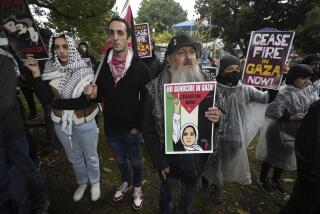The way forward
When Pope Benedict XVI sets foot in Jerusalem today, he will be only the third pope in history to do so. The visit comes at a crucial time for both Catholics and Jews.
For the pope, it is an important opportunity to put behind him the fiasco of having welcomed an avowed Holocaust denier, Bishop Richard Williamson, back into the church -- a decision he was later forced to reverse.
For Israel, the visit is a welcome opportunity to assuage critics -- that despite the war in Gaza and the election of a more conservative government, the country remains a place where Jews, Christians and Muslims are free to practice their faiths.
But if the Catholic Church is going to begin to move forward in cooperation with the Jewish people, it is going to have to acknowledge the past. And you don’t have to go far back in history to find a time when the church’s relationship with the Jews was based on persecution, hate or abject indifference.
When Theodor Herzl came to the Vatican in 1904 to plead with Pope Pius X to alleviate the suffering of European Jews, the pope bluntly told him that the “Jews have not recognized our lord, therefore we cannot recognize the Jewish people.” Herzl countered that perhaps terror and persecution were not the right means by which to enlighten them, but the pope rebuffed him: “They had ample time to acknowledge Christ’s divinity without pressure, but they didn’t.”
The Jews’ rejection of Christ remained the dominant guiding principle of church policy toward the Jews through most of the 20th century.
At the height of Adolf Hitler’s Final Solution, for example, the U.S. ambassador to the Vatican, Myron C. Taylor, wrote to the Vatican secretary of state, Cardinal Luigi Maglione, on Sept. 26, 1942, informing him that the United States had received a report of mass executions and deportations of hundreds of thousands of Jews from Poland, Belgium, Holland, France and Slovakia. Taylor wrote that he would appreciate it if the Vatican could verify the report, and added, “I should like to know whether the Holy Father has any suggestions ... in which the forces of civilized public opinion could be utilized ... to prevent a continuation of these barbarities.”
Three weeks later, the Vatican replied in an unsigned statement to Harold Tittman, an American diplomat at the Holy See, that the church had also heard such reports from other sources but had yet to verify them. Tittman forwarded the information to the State Department, commenting that he regretted that “the Holy See was not more helpful” and that he “received the impression ... that the Vatican had no practical suggestions to make.”
Although the Vatican had no suggestions on how to save the Jews, it did have strong opinions about keeping European Jews out of Palestine. On June 22, 1943, the Vatican sent these points to its apostolic delegation in Washington: “If the greater part of Palestine is given to the Jewish people, this would be a severe blow to the religious attachments of Catholics to this land. To have the Jewish people in the majority would interfere with the peaceful exercise of these rights in the Holy Land already vested in Catholics.”
Even after Israel was founded in 1948, the Vatican’s official newspaper insisted: “Modern Israel is not the true heir of biblical Israel. ... Therefore, the Holy Land and its sacred sites belong to Christianity, the true Israel.”
In 1964, during Pope Paul VI’s historic visit to Jerusalem, he refused to publicly utter the word “Israel,” and even his thank-you note to then-President Zalman Shazar was mailed to Tel Aviv, lest he be accused of acknowledging Israel’s sovereignty in Jerusalem.
Though there is much to find fault with in the church’s past, we must also recognize the difficult path charted by a few courageous popes to correct a 2,000-year-old denigration of a people that Pope John Paul II referred to as Christendom’s “elder brothers in faith.”
In 1938, Pope Pius XI commissioned an American priest to draft an encyclical on the evils of Hitler’s racism and anti-Semitism, a document that might have gone a long way toward averting the full scope of the Holocaust. But Pius XI died before its release, and his successor, Pius XII, chose to ignore its existence.
In the 1960s, Pope John XXIII finally planted the seeds for a new relationship when he declared that the church “decries persecutions and displays of anti-Semitism directed against Jews at any time and by anyone.”
But it wasn’t until John Paul II -- perhaps the most influential pope of the 20th century -- that the church turned in an entirely different direction. John Paul II was the first pope to visit a synagogue, to visit Auschwitz, to recognize the state of Israel, to pray at the Western Wall, to personally apologize for centuries of Christian anti-Semitism, and to declare Judaism a sister religion with intrinsic and external values.
He was aided in that quest by then-Cardinal Joseph Ratzinger, who would become Pope Benedict XVI. Though raised in Nazi Germany, Ratzinger played a significant role in assuring the Vatican’s formal recognition of the Jewish state, and in his 2000 Christmas reflections wrote about the Holocaust: “It cannot be denied that an insufficient resistance to this atrocity on the part of Christians can be explained by an inherited anti-Judaism present in the hearts of not a few Christians.”
On the 70th anniversary of the outbreak of World War II, Jews around the world need to acknowledge that the Catholic Church of 2009 is no longer the same institution it was under Pius XII. Jews and Catholics may have their differences, but Benedict XVI’s pilgrimage to Jerusalem confirms that the Catholic Church, once a main source of anti-Semitism, is today an important voice in validating the Jewish people’s right to fulfill a historic and spiritual destiny.
More to Read
Sign up for Essential California
The most important California stories and recommendations in your inbox every morning.
You may occasionally receive promotional content from the Los Angeles Times.










